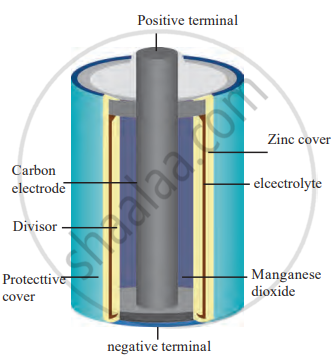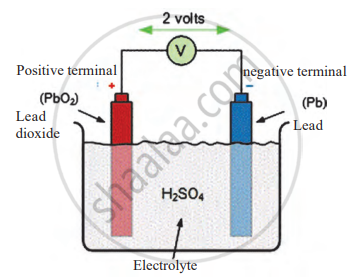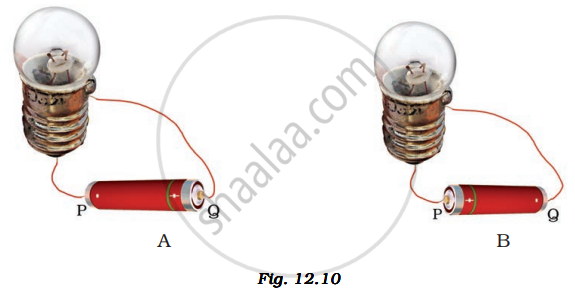- When a nickel-cadmium battery is discharged, it transforms chemical energy into electrical energy, and when it is recharged, it transforms electrical energy back into chemical energy.
- Provides a potential difference of 1.2V. Commonly used in devices that require frequent charging and portability.
Topics
Measurements and Experimentation
- Measurements
- Physical Quantities
- Unit and Its Types
- Unit Systems
- International System of Units (Si System)
- Unit Prefixes
- Measurement of Length
- Measuring Smaller Distances
- Measuring Larger Distances
- Measurement of Mass
- Measurement of Time
- Rules and Conventions for Writing SI Units and Their Symbols
- Vernier Callipers
- Principle of Vernier
- Screw Gauge
- Principle of Screw Gauge
- Simple Pendulum for Time
- A Time Period of Oscillation and Frequency
- Measurements Using Common Instruments
Motion in One Dimension
- Scalar and Vector Quantities
- Motion and Rest
- Motion Along a Straight Line
- Distance and Displacement
- Speed
- Types of Speed
- Velocity
- Types of Velocity
- Distinguish Between Speed and Velocity
- Acceleration and Retardation
- Types of Acceleration
- Acceleration Due to Gravity (Earth’s Gravitational Acceleration)
- Graphical Representation of Motion
- Displacement - Time Graph Or Distance - Time Graph
- Velocity - Time Graphs
- Acceleration - Time Graph
- Motion Under Gravity
- Equations of Motion by Graphical Method
- Derivation of Velocity - Time Relation by Graphical Method
- Measuring the Rate of Motion - Speed with Direction
- Rate of Change of Velocity
Laws of Motion
- Effect of Force
- Types of Force: Contact Force
- Types of Force: Non-Contact Force
- Newton's First Law of Motion
- Inertia and Mass
- Types of Inertia
- Linear Momentum
- Change in Momentum
- Rate of Change of Momentum
- Newton’s Second Law of Motion
- Newton’s Second Law of Motion in Terms of Rate of Change of Momentum
- Newton's Third Law of Motion
- Force Due to Gravity
- Acceleration Due to Gravity (Earth’s Gravitational Acceleration)
- Free Fall
- Concept of Mass and Weight
- Gravitational Units of Force
- Newton’s Universal Law of Gravitation
Fluids
Fluids
- Introduction of Fluid
- Variation of Pressure with Depth in a Fluid
- Thrust and Pressure
- Factors Affecting Pressure
- Pressure of liquid
- Pressure Exerted by a Liquid Column
- Law of Liquid Pressure
- Consequences of Liquid Pressure
- Pascal’s Law
- Application of Pascal’s Law
- Hydraulic Machines: Hydraulic Press (Or Bramah Press)
- Atmospheric Pressure
- Consequences of Atmospheric Pressure
- Measurement of Atmospheric Pressure
- Mercury Barometer (Simple Barometer)
- Fortin’s Barometer
- Aneroid Barometer
- Variation of Atmospheric Pressure with Altitude
- Weather Forecast by the Use of Arometer
- Altimeter
Buoyancy, Upthrust
- Buoyancy Force (Upthrust Force)
- Characteristic Properties of Upthrust
- Reason for Upthrust
- Upthrust is Equal to the Weight of Displaced Liquid (Mathematical Proof)
- Archimedes Principle
- Solid Bodies with density (ρ) greater than density of liquid (ρL) sink while with density (ρ) less than density of liquid (ρL) Float
- Density and It’s Unit
- Relative Density and Its Unit
- Relationship Between Density and Relative Density
- Determination of Relative Density of a Solid Substance by Archimedes’ Principle
- Determination of Relative Density of a Liquid by Archimedes’ Principle
- Principle of Floatation (Laws of Flotation)
- Relation Between Volume of Submerged Part of a Floating Body, the Densities of Liquid and the Body
- Application of the Principle of Floatation
Heat and Energy
- Heat and Its Unit
- The Temperature and a Thermometer
- Expansion of Substances (Thermal Expansion)
- Expansion of Solids
- Expansion of Liquids
- Expansion of Gases
- Anomalous Expansion of Water
- Anomalous Behaviour of Water
- Consequences of Anomalous Expansion of Water
- Concept of Energy Flow in an Ecosystem
- Application of Laws of Thermodynamics in Energy Flow
- Source of Energy
- Conventional energy resources or non-renewable energy resources
- Solar Energy
- Solar Energy Devices
- Wind Energy
- Hydroelectric Energy
- Bio-energy
- Energy from the Sea
- Geothermal Energy
- Nuclear Energy
- Conservation of Coal, Petroleum, and Natural Resources
- Protecting our environment
- Energy Degradation
- Green House Effect
- Preventive Measures of Green House Effect
- Global Warming
- Preventive Measures of Global Warming
- Future Predictions of Global Warming
Light
- Reflection of Light
- Types of Reflection
- Terms Used in Reflection of Light
- Law of Reflection of Light
- Verification of the Law of Reflection of Light
- Formation of Image by Reflection: Real and Virtual Image
- Formation of Image of a Point Object by a Plane Mirror
- Image of an Extended Object Formed by a Plane Mirror
- Position of Image
- Lateral Inversion
- Plane Mirror
- Images Formed by a Plane Mirrors
- Images Formed in Two Inclined Mirrors
- Images Formed in a Pair of Mirrors Placed Parallel to Each Other
- Images Formed by Two Mirrors Placed Perpendicular to Each Other
- Spherical Mirrors
- Rules for the Construction of Image Formed by a Spherical Mirror
- Focus and Focal Length
- Images Formed by Spherical Mirrors
- Concave Mirror
- Image Formation by Concave Mirror
- Convex Mirror
- Image Formation by Convex Mirror
- Relationship Between the Focal Length and Radius of Curvature
- Sign Convention
- Mirror Equation/Formula
- Distinction Between a Plane Mirror, Concave Mirror and Convex Mirror
Sound
- Sound
- Production of Sound
- Propagation of Sound
- Sound Need a Medium to Travel
- Characteristics of a Sound Wave
- Representation of a Wave
- Relationship Between the Wavelength, Wave Velocity and Frequency
- Speed of Sound (Velocity of Sound)
- Speed of Sound in Different Media
- Difference Between the Sound and Light Waves
- Factors Affecting Speed of Sound in Gas
- Factors Not Affecting Speed of Sound in a Gas
- Experimental Determination of Speed of Sound in Air
- Properties of Sounds
- Audibility and Range
- Ultrasonic Sound Or Ultrasound
Electricity and Magnetism
Electricity
- Electric cell
- Electric Current
- Symbols and Functions of Various Components of an Electric Circuits
- Electric Circuit
- Types of Circuits: Simple Circuit
- Conductors and Insulators
- Flow of Charges (Electrons) Between Conductor
- Direction of the Electric Current - Conventional and Electronic Flow
- Potential and Potential Difference
- Resistance (R)
- Factors Affecting the Resistance of a Conductor
- Ohm's Law (V = IR)
- Conservation of Electrical Energy
- Social Initiatives for Energy
Magnetism
- Magnet
- Magnetic and Non-magnetic Materials
- Induced Magnetism
- Properties of magnetic lines of force
- Earth’s Magnetism
- Plotting of Uniform Magnetic Field Lines of Earth
- Plotting of Non Uniform Magnetic Field of a Strong Bar Magnet and Neutral Points
- Neutral Points in Magnetic Fields
- Electromagnet
- Making of an Electromagnet
- Permanent Magnet and Electromagnet
- Applications of Electromagnets
- Introduction of Electric Cell
- Types of Electric Cells
- Experiment
Introduction of Electric Cell:
An electric cell is a device that provides energy to create a steady and uniform flow of electric charges through a circuit. It acts as a power source, ensuring that a constant potential difference (voltage) is maintained between its two terminals. This potential difference is necessary to push the electric charges, or current, through the circuit, powering devices connected to it.
Applications:
- Electric cells are versatile and used in a wide range of applications. They power small devices like wristwatches as well as larger systems like submarines.
- Different types of electric cells are designed to meet various energy needs. For example, solar cells are a type of electric cell that converts sunlight directly into electricity, making them environmentally friendly and useful for renewable energy solutions.
- Electric cells are essential for providing the energy needed to operate electrical devices and maintain a continuous flow of electric current.
Types of Electric Cells:
1. Dry Cell
A dry cell is a common type of electric cell used in devices like radios, wall clocks, and flashlights. It is simple and convenient, available in different sizes, and can be used in any position.

Dry Cell
Structure and Components,
- The outer layer is made of zinc (Zn) metal, which serves as the negative terminal.
- Inside the zinc casing, there is an electrolyte made of a wet pulp containing zinc chloride (ZnCl₂) and ammonium chloride (NH₄Cl). This electrolyte carries electricity through charged ions.
- At the centre of the cell, there is a graphite rod that acts as the positive terminal. Around this rod is a paste of manganese dioxide (MnO₂).
Chemical reactions between the electrolyte and the manganese dioxide produce electric charges on the graphite rod and the zinc layer, creating a flow of electric current. The reactions happen slowly, which means dry cells can’t provide very large currents but are suitable for low-power devices.
2. Lead-Acid Cell
Rechargeable: Can be recharged after losing charge.
- Contains two electrodes: one made of lead (Pb) and the other of lead dioxide (PbO₂), both immersed in dilute sulphuric acid.
- The lead dioxide electrode (PbO₂) is positively charged, and the lead electrode (Pb) is negatively charged, creating a potential difference of approximately 2V.
- Chemical reactions generate charges, causing electric current to flow through connected devices, such as a bulb.
These cells can supply large currents and are used in cars, trucks, motorcycles, and backup power supplies (UPS).

Lead-Acid Cell
3. Ni-Cd Cell (Nickel-Cadmium Cell)
Portable and Rechargeable: Ideal for gadgets that need to be carried around, like cameras and portable electronics.
Experiment
1. Aim: To explore the internal structure of a dry cell and understand how it produces electric current.
2. Requirements: A dry cell and tools to remove the outer coating carefully.
3. Procedure
- Remove the outer coating of a dry cell carefully.
- Observe the whitish zinc (Zn) layer, which is the negative terminal.
- Gently break the zinc layer to see the electrolyte, a wet pulp of zinc chloride (ZnCl₂) and ammonium chloride (NH₄Cl) with charged ions.
- In the centre, locate the graphite rod, the positive terminal, surrounded by manganese dioxide (MnO₂) paste.

Dry Cell
4. Conclusion: The dry cell contains chemicals that react to produce electric charges on the graphite rod and zinc layer, allowing electric current to flow in a circuit. Due to the slow chemical reactions in the wet pulp, the current produced is not very large, but the cell is long-lasting and easy to use in any orientation, making it suitable for portable devices.
If you would like to contribute notes or other learning material, please submit them using the button below.
Related QuestionsVIEW ALL [48]
Arrange in sequence
| A CELL | A DEVICE | ELECTRICAL ENERGY |
| IS CALLED | IN TO | CHEMICAL ENERGY |
| THAT CONVERTS |

